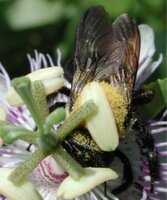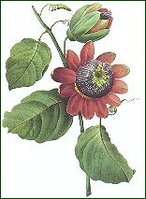Passion flower
|
|
| Passion flower | ||||||||||||
|---|---|---|---|---|---|---|---|---|---|---|---|---|
| Missing image Passion-flower.jpg | ||||||||||||
| Scientific classification | ||||||||||||
| ||||||||||||
| Species | ||||||||||||
|
About 500 species, including: |
Passion flower refers to vines in the genus Passiflora—flowering plants known for their showy flowers. The plants were named for the passion of Christ, because the flower structure seemed symbolic of Jesus' scourging, crowning with thorns, and crucifixion. Passion flowers are native to tropical and sub-tropical America. However, a number of species of Passiflora are cultivated outside their natural range (where some have become established) because of their beautiful flowers.
Most of decorative passifloras have a unique blossom structure: one which requires a large bee to effectively pollinate (see photo below). In the American tropics, wooden beams are mounted near passionfruit plantings to encourage Carpenter bees to nest. At the same time, sizes and structures of flowers of various species of passiflora vary. Some species can be pollinated by hummingbirds and bumble bees, others by wasps, still others are self-pollinating.
The passion fruit vine of commerce, Passiflora edulis (pt:maracujá, es:maracuyá), is cultivated extensively in the Caribbean and south Florida for its fruit, used as source of juice.
Maypop (Passiflora incarnata), a common wildflower in the southern US, is a subtropical representative of this mostly tropical family. Its fruit is edible, but is quite seedy and mostly benefits wildlife. As with other passifloras, it is the larval food of a number of butterfly species.
Banana poka or Curuba (Passiflora mollissima) originally from Central Brazil, is an invasive weed, especially on the islands of Hawaii, where it is spread by feral pigs eating the fruits. It overgrows and smothers stands of endemic vegetation, mainly on roadsides. Its fruits are edible, but not as much sought-after as maracujá.
Medical uses
Passion flower has a long history of use among Native Americans, in both North and Central America. It is used to treat insomnia, hysteria, and epilepsy, and is also valued for its painkilling properties. It has been found to contain beta-carbolines in the harmala family, an MAOI which has sedative properties and hallucinogenic properties at higher doses, typically used in conjunction with DMT to facilitate oral consumption.
External links
- The Passiflora Society International (http://www.passiflora.org/)
- Passiflora online (http://www.passionflow.co.uk/)
- Passiflora edulis (http://www.crfg.org/pubs/ff/passionfruit.html)
Template:Commons Template:Commonsde:Passionsblume it:Passiflora nl:Passiebloem th:เสาวรส zh:西番蓮



